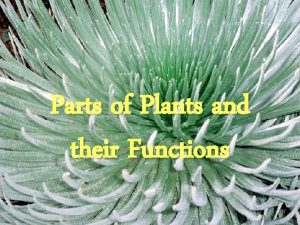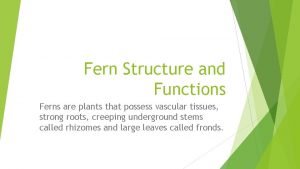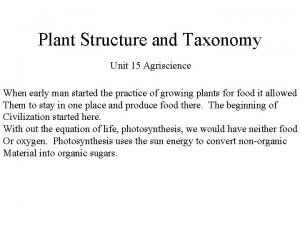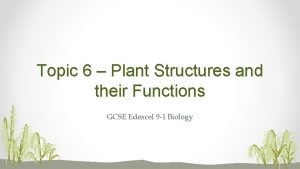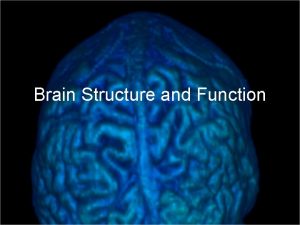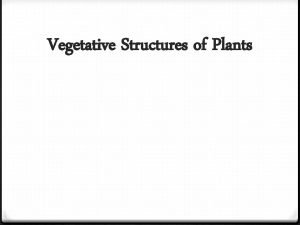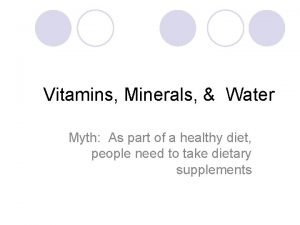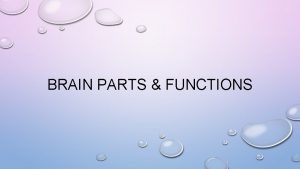Topic 6 Plant Structures and their Functions GCSE






















- Slides: 22

Topic 6 – Plant Structures and their Functions GCSE Edexcel 9 -1 Biology

Photosynthesis • This is the process that plants and algae use to make their own food. • Plants are producers as they make their own food. • Photosynthetic organisms are the main producers of food and therefore biomass. • Biomass is the mass of living material at a particular stage in a food chain.

Photosynthesis • Photosynthesis is an endothermic reaction. What does this mean? • It takes in energy in the form of light to turn it into chemical energy. • As shown below, light energy is used to react carbon dioxide from the air and water from the soil in order to create glucose (a sugar) and release oxygen into the air as a by-product.

Limiting Factors • What are three limiting factors of photosynthesis? • As light intensity increases, so does the rate of photosynthesis. However, this is only true to a certain point where photosynthesis occurs at its optimum rate so light intensity increasing has no effect. This is also true for CO 2 concentration. • Temperature is slightly different. The rate of photosynthesis will increase as temperature increases, but will start to decline if it gets too hot as enzymes will begin to denature.

Limiting Factors • Carbon dioxide is a limiting factor because it increases the rate of photosynthesis due to more CO 2 being available for sugars to be made. • Temperature is a limiting factor because it increases the kinetic energy if molecules and increases the rate of enzyme activity making photosynthesis faster.

Root Hair Cells • Root hair cells have long extensions that stretch into the soil. • This also allows a large surface area so osmosis can occur at a more optimum rate. This means that more water molecules cross the cell membrane into the cell at a time. • It also gives a large surface area for mineral ions to enter the root hair cells by diffusion and active transport.

Xylem • Xylem vessels are dead cells which have no cytoplasm or cell contents. This allows for more space for water containing mineral ions to pass through. • They have holes called pits in the cell wall to allow water and ions to move out. • The walls are strengthened by lignin rings which prevents them from collapsing. • They have no end walls so simply form a long tube for easy flow of water.

Phloem • Phloem vessels contain sieve tube elements which have little cytoplasm to maximise the space for the transport of sucrose. • It also has companion cells which have many mitochondria to supply energy from respiration for active transport of sucrose into and out of sieve tubes. • Sucrose is translocated around the plant in the phloem.

• Transpiration is the movement of water through a plant from the roots to the leaves. • The movement of water from the roots to the leaves is called the transpiration stream. Transpiration • Water vapour evaporates from leaves (mainly from stomata) • Water drawn from leaf cells and xylem onto leaf surface. • Water drawn up the stem through xylem from roots. • Water enters roots by osmosis.

Stomata • Stomata are found mainly on the lower surface of the leaf. • When the guard cells take in water by osmosis, they swell (turgid) and this causes the stoma to open (left picture). • When the guard cells lose water, they become flaccid and the stoma closes.

Sucrose • • • Translocation is the transport of sucrose around a plant via the phloem. Sucrose is produced in leaves from glucose formed in photosynthesis. This sucrose (dissolved sugars) are needed: -for growth in growing regions of plant -to be converted into starch and stored for later use • A storage organ of a plant may be the fruit of the plant (i. e. potato)

Leaf Adaptations

Water Uptake in Plants • What are three factors affecting transpiration? • Light Intensity • Air Movement • Temperature • High light intensity causes the stomata to open. This increases the rate of evaporation from the leaf so more water is taken in to replace this loss. • Wind blows wet air away from stomata so the diffusion gradient is high. Therefore more air movement results in a higher transpiration rate. • The higher the temperature, the more energy water molecules have so they move faster and this means there is a higher transpiration rate.

Rate of Transpiration • Rate of transpiration is measured using a potometer: 1) Note position of air bubble on ruler at start. 2) Note position of air bubble after known number of minutes. 3) Divide distance moved by the time taken to do so.

Plant Adaptations • Plants have adaptations which allow for them to survive in extreme conditions. • Dry Conditions • Tropical Conditions • Waterlogged Soil • In very hot or dry places, • These plants have • This means no air spaces so plants such as marram grass adapted to wet root cells have difficulty have developed: conditions and low light obtaining oxygen for • Waxy cuticles to reduce intensity through: water loss. respiration. Adaptation • Large leaves to take in • Leaf hairs to trap moist air. include: as much light. • Folded leaves to reduce air • Spongy tissue in roots that movement around stoma so • Leaves with drip tips so stores oxygen. water runs off them. lower concentration gradient. • Stems and leaves that climb up the trees to obtain more light with the plant’s roots still in ground. • Fine surface roots that take in oxygen at water surface.

Plant Hormones • A tropism is a plant’s response to a stimulus (change in environment) by growing. A positive tropism is when the plant grows towards the stimulus. • Plant shoots show positive phototropism as they grow towards light. • Plant roots show positive gravitropism (geotropism) as they grow towards pull of gravity.

Auxins and Tropisms • Plant hormones are chemicals that cause changes in the plant. • Auxins are plant hormones that make cells elongate. They are affected by light and cause phototropism in shoots.

Uses of Plant Hormones Plant hormones such as auxins, gibberellins and ethene can be used commercially. Selective weed killers contain auxins. The weed plants compete with crops for water and minerals. If the crops are narrow-leaved and the weed is broadleaved, then auxins are used. Auxins stimulate growth of shoots and so when the weeds absorb more auxins, they grow too quickly and die.

Uses of Plant Hormones Gardeners take cuttings of plants that grow into new plants. They dip the ends of these into rooting powder which contains auxins that cause the stalk to produce roots quickly. This helps the cuttings grow.

Uses of Plant Hormones Gibberellins stimulate germination of seeds which increases crop yields. They also stimulate the production of flower and fruit so yield is again increased. Gibberellins stimulate stem elongation. If done on crops like sugar cane, yield is increased!

Uses of Plant Hormones Gibberellins sprayed on to flowers can stop seeds from developing in the fruits. They also make the fruits larger. People prefer larger, seedless fruits so they are worth more money.

Uses of Plant Hormones Ethene is a gas released by some ripe fruits such as bananas. This ethene gas acts as a ripening hormone on other fruits. Unripe bananas release very little or none of this gas.
 Part of leaf
Part of leaf 4 main parts of a plant and their functions
4 main parts of a plant and their functions Fern structure and function
Fern structure and function 6 parts of a plant and their functions
6 parts of a plant and their functions Homology
Homology Paragraph writing strategies
Paragraph writing strategies Narrowing down a topic exercises
Narrowing down a topic exercises Unit 15 plant structures and taxonomy
Unit 15 plant structures and taxonomy Tronsmo plant pathology and plant diseases download
Tronsmo plant pathology and plant diseases download Tronsmo plant pathology and plant diseases download
Tronsmo plant pathology and plant diseases download Albugo eye
Albugo eye Plant
Plant Limbic system structures and functions
Limbic system structures and functions Cell organelle graphic organizer
Cell organelle graphic organizer Limbic system structures and functions
Limbic system structures and functions Eukaryotic cells
Eukaryotic cells Vegetative structure
Vegetative structure Topic 1 relations and functions
Topic 1 relations and functions What are vitamins functions
What are vitamins functions Function of vitamins
Function of vitamins Animal vs plant cell venn diagram
Animal vs plant cell venn diagram Plant introduction
Plant introduction Plant breeding for disease resistance
Plant breeding for disease resistance

